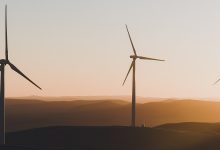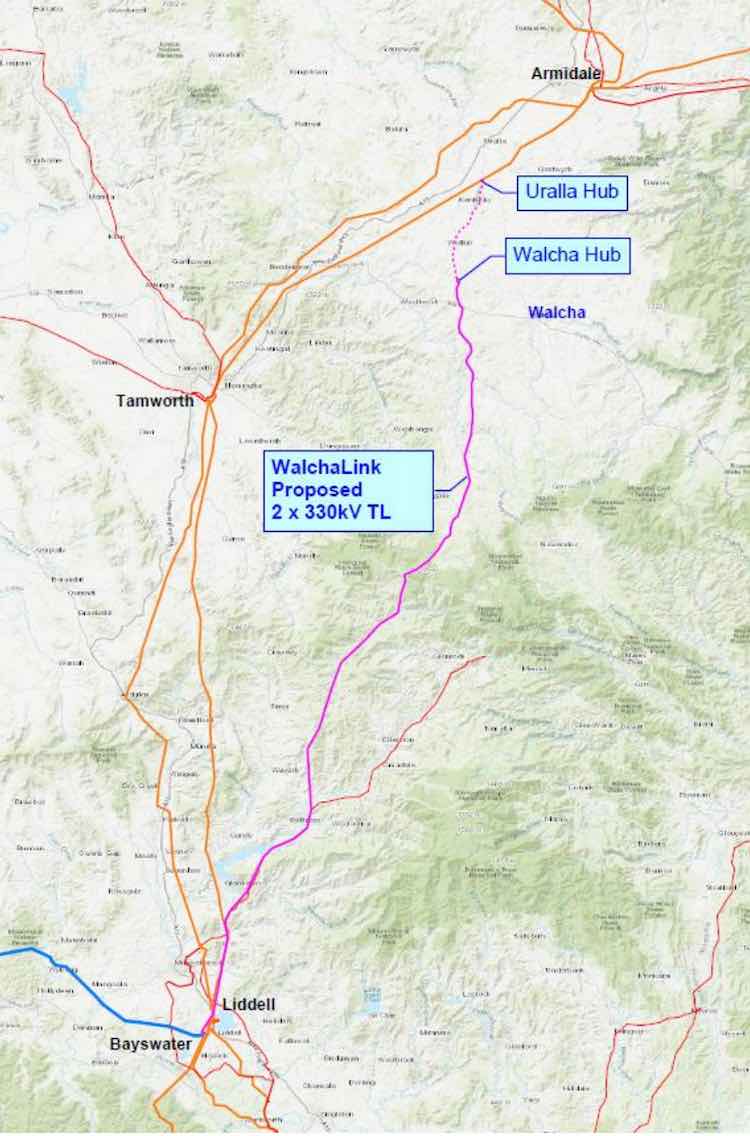The outfit behind one of the biggest renewable energy and storage projects currently proposed for the National Electricity Market has unveiled plans to build a major transmission line, linking the New South Wales coal power centre of Liddell to the future solar and wind energy hub of Uralla through the Walcha Plateau.
The so-called WalchaLink is being proposed by Walcha Energy, a joint venture between Mirus Energy and Energy Estate, that aims to develop roughly 3,400MW of wind generation capacity, up to 700MW of solar, and multiple 500MW/3000MWh pumped hydro energy storage facilities between Walcha and Uralla.
The companies said on Wednesday that the proposed 178km double circuit 330kV line stretching from Liddell to Walcha Road (see map below) would be a “generator led private transmission development,” outside of the usual regulatory processes and underwritten by Walcha Energy’s pipeline of renewable energy and storage projects.
The WalchaLink would then, in the future, have potential to “mesh with the shared network” at the Uralla Hub and facilitate a transmission pathway for generation within the wider New England REZ to the NSW load centres and a second connection to Queensland.
For now, however, Walcha Energy says it is focusing on seeking partners to support the development of the WalchaLink transmission infrastructure, as well as the development of the Uralla Hub, which will connect the initial generation projects developed by Walcha Energy.
The major private transmission project proposal comes at a time when state governments and the Australian Energy Market Operator scramble to plan for the arrival of many thousands of megawatts of new renewable energy capacity on the NEM to replace the nation’s rapidly retiring coal power fleet.
In New South Wales, where the state is facing the imminent closure of coal plants at Liddell, and then Vales Point, with Bayswater and Eraring following in 2035 – and where a recent report forecast that 100% renewables could be reached by 2030 – the task is an urgent one.
As RenewEconomy has reported, NSW energy minister Matt Kean has already announced an ambitious infrastructure roadmap to deal with these coal closures, including an auction system, support for storage, and the creation of at least four new renewable energy zones that aim to encourage 12GW of new capacity by 2030.
On top of that, the AEMO last year finalised its Integrated System Plan, the 20-year blueprint to make sure that the shift from coal to a grid dominated by wind, solar and storage can happen smoothly and delivers the promised savings in costs and emissions.
So where does the WalchaLink fit with these much laboured-over plans, not to mention with the usual regulatory processes and assessment tests that usually guide the development of new transmission infrastructure, including the regulatory investment test for transmission (RIT-T)?
“The [NSW Electricity Infrastructure Roadmap] highlights that new transmission infrastructure and large scale, long term storage will be crucial in unlocking the new generation and to ensuring a reliable and strong transmission pathway to the load centres of NSW,” a WalchaLink ‘partnership opportunity’ document shared with RenewEconomy on Wednesday says.
“The Walcha Energy Project is in a key location in the southern part of the NE REZ. Our proposed transmission development plan is entirely consistent with the grid development from the REZ to the Hunter Valley outlined in the AEMO 2020 ISP and TransGrid 2020 TAPR.
“Storage will be located between the generation and the load / existing grid to maximise the use and efficiency of new transmission infrastructure. The Dungowan Pumped Hydro Project is ideally located at the southern edge of the NE REZ on the proposed transmission line.”
Energy Estate’s Simon Currie argues, further, that Walcha is ideally placed to build the transmission line, thanks to its collective expertise – including from “one of the best thinkers about transmission” electrical engineer John Diesendorf; its connection to the area through its major generation project plans; and its potential ability to get the job done much faster than it would be via traditional pathways.
“Australia’s is not going to achieve any of its current renewable energy or decarbonations goals with the current RIT-T process,” Currie told RenewEconomy.
“It’s not an ideological thing, it just doesn’t work any more. …We’re all accused of undermining the integrity of the system. No, we’re not, it just doesn’t work any more.
“We’re in a unique position because we control the generation,” Currie added. “We have the ability to underpin this project in a way that other proposed private [entities] don’t.
“We are aligned with the goals of the [NSW government’s] roadmap, we offer the opportunity to big projects to connect. But we’re not dependent on people optioneering… We’re going to go it alone, we’re going to take on this risk, we’re going to bring on partners.
“We feel this really strong commitment, we’re part of the community, and Mark in particular,” he adds, referring to Walcha Energy director, Mark Waring, who owns a house in Walcha.
“The community and social licence mean a huge amount to us. If the best thing to do is to spend $10 million more and go behind the [Walcha Plateau] rather than in front of the hill for the transmission line, then that’s what we need to do.
“In order to get 8GW of wind coming off the new REZ, which we clearly need, we need to leave as much existing capacity on the existing lines, as well as more from the north.
“We need to make sure that we don’t overload the Plateau. We believe that this line makes economic sense, makes environmental sense, will be part of the story that will enable Tomago [aluminium smelter] to commit to stay [online],” Currie said.
“Walcha Link is part of a broader Hunter re-industrialisation and decarbonisation plan for Energy Estate.”












